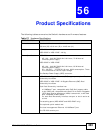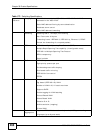
Chapter 56 Product Specifications
XGS-4526/4528F/4728F User’s Guide
466
Multicast VLAN
Registration (MVR)
Multicast VLAN Registration (MVR) is designed for applications
(such as Media-on-Demand (MoD)) using multicast traffic
across a network. MVR allows one single multicast VLAN to be
shared among different subscriber VLANs on the network.
This improves bandwidth utilization by reducing multicast
traffic in the subscriber VLANs and simplifies multicast group
management.
IP Multicast With IP multicast, the Switch delivers IP packets to a group of
hosts on the network - not everybody. In addition, the Switch
can send packets to Ethernet devices that are not VLAN-aware
by untagging (removing the VLAN tags) IP multicast packets.
RIP RIP (Routing Information Protocol) allows a routing device to
exchange routing information with other routers.
OSPF OSPF (Open Shortest Path First) is a link-state protocol
designed to distribute routing information within an
autonomous system (AS). An autonomous system is a
collection of networks using a common routing protocol to
exchange routing information. OSPF is best suited for large
networks.
DVMRP DVMRP (Distance Vector Multicast Routing Protocol) is a
protocol used for routing multicast data within an autonomous
system (AS). DVMRP provides multicast forwarding capability
to a layer 3 switch that runs both the IPv4 protocol (with IP
Multicast support) and the IGMP protocol.
VRRP Virtual Router Redundancy Protocol (VRRP), defined in RFC
2338, allows you to create redundant backup gateways to
ensure that the default gateway of a host is always available.
STP (Spanning Tree
Protocol) / RSTP (Rapid
STP)/MSTP (Multiple
Spanning Tree Protocol)
(M)(R)STP detects and breaks network loops and provides
backup links between switches, bridges or routers. It allows a
Switch to interact with other (M)(R)STP-compliant switches in
your network to ensure that only one path exists between any
two stations on the network.
Loop Guard Use the loop guard feature to protect against network loops on
the edge of your network.
IP Source Guard Use IP source guard to filter unauthorized DHCP and ARP
packets in your network.
Link Aggregation Link aggregation (trunking) is the grouping of physical ports
into one logical higher-capacity link. You may want to trunk
ports if for example, it is cheaper to use multiple lower-speed
links than to under-utilize a high-speed, but more costly,
single-port link.
Port Authentication and
Security
For security, the Switch allows authentication using IEEE
802.1x with an external RADIUS server and port security that
allows only packets with dynamically learned MAC addresses
and/or configured static MAC addresses to pass through a port
on the Switch.
Authentication,
Authorization and
Accounting
The Switch supports authentication, authorization and
accounting services via RADIUS and TACACS+ AAA servers.
Table 172 Firmware Specifications
FEATURE DESCRIPTION


















